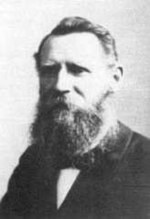Woldemar Voigt
| Woldemar Voigt | |
|---|---|

Woldemar Voigt (1850–1919)
|
|
| Born | 2 September 1850 Leipzig, Kingdom of Saxony |
| Died |
13 December 1919 (aged 69) Göttingen, Germany |
| Residence | Germany |
| Nationality | German |
| Fields | Physicist |
| Institutions | University of Göttingen |
| Alma mater | University of Königsberg |
| Doctoral advisor | Franz Ernst Neumann |
| Doctoral students |
Paul Drude Karl Körner Alfred A. Robb |
| Known for |
Voigt notation Voigt profile Voigt effect |
Woldemar Voigt (German: [foːkt]; 2 September 1850 – 13 December 1919) was a German physicist, who taught at the Georg August University of Göttingen. Voigt eventually went on to head the Mathematical Physics Department at Göttingen and was succeeded in 1914 by Peter Debye, who took charge of the theoretical department of the Physical Institute. In 1921, Debye was succeeded by Max Born.
Voigt was born in Leipzig, and died in Göttingen. He was a student of Franz Ernst Neumann. He worked on crystal physics, thermodynamics and electro-optics. His main work was the Lehrbuch der Kristallphysik (textbook on crystal physics), first published in 1910. He discovered the Voigt effect in 1898. The word tensor in its current meaning was introduced by him in 1898.Voigt profile and Voigt notation are named after him. He was also an amateur musician and became known as a Bach expert (see External links).
In 1887 Voigt formulated a form of the Lorentz transformation between a rest frame of reference and a frame moving with speed in the direction. However, as Voigt himself said, the transformation was aimed at a specific problem and did not carry with it the idea of a general coordinate transformation, as is the case in relativity theory.
...
Wikipedia


